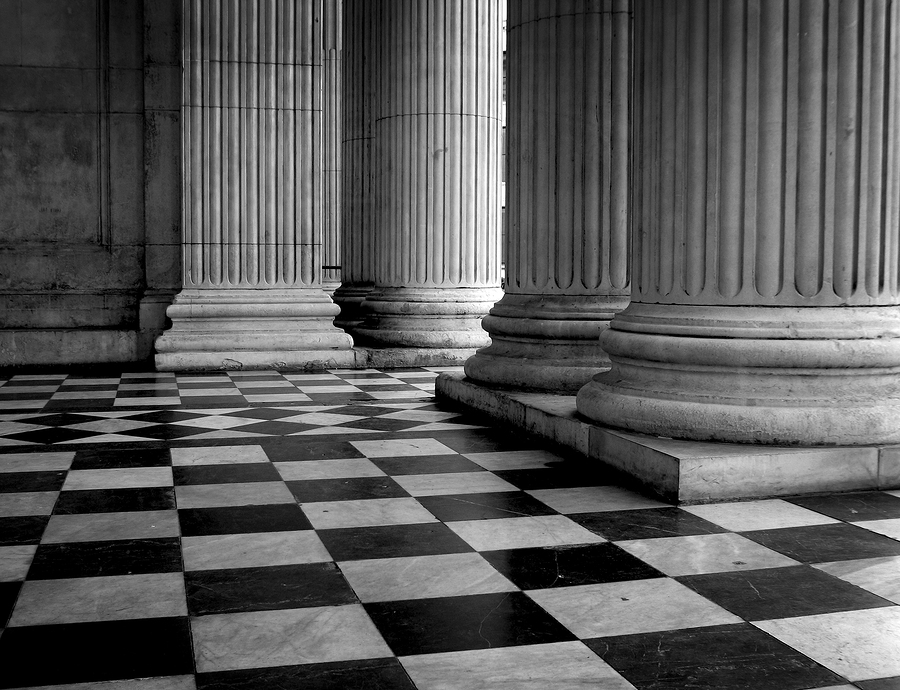The Checkered Flooring
The mosaic pavement of the lodge is discussed in the lecture of the first degree.
This is commonly described as the checkered carpet which covers the floor of the lodge. The lecture says that the mosaic pavement “is a representation of the ground floor of King Solomon’s Temple” and is “emblematic of human life, checkered with good and evil.”
In the account of King Solomon’s Temple in the Bible, the ground floor is said to be made of pine or fir, depending on which translation of the Bible that you read (1 Kings 6:15). It is hard to imagine that pine or fir flooring would be particularly mosaic in nature. However, it can be agreed that the mosaic pavement represents the ground floor of King Solomon’s Temple in the Entered Apprentice degree because that ceremony symbolically takes place in that location. While these facts may not be particularly intriguing, the symbolism of the checkered carpeting presents some interesting concepts.
Mackey’s Encyclopedia of Freemasonry discusses the symbol of the mosaic pavement.
The mosaic pavement is an old symbol of the Order. It is met with in the earliest rituals of the last century. It is classed among the ornaments of the lodge along with the indented tessel and the blazing star. Its party-colored stones of black and white have been readily and appropriately interpreted as symbols of the evil and good of human life.
So from this information, it can be understood that the concept of duality has played a part in Masonic symbolism since the early days of the fraternity. While duality is not often discussed in the ritual of the Blue Lodge, the Scottish Rite mentions this concept numerous times. The Rite makes
the ideas of dualism, or opposition, in the universe an important part of its theme. Indeed, the ideas of the Kabbalah and the Alchemists are used in the Scottish Rite to discuss this concept in several of the degrees.2
The lecture pertaining to the 15th Degree, Knight of the East and West, discusses the idea of duality or good and evil as a conflict. Pike writes “God is great, and good, and wise. Evil and pain and sorrow are temporary, and for wise and beneficent purposes…Ultimately, Good will prevail, and Evil be overthrown.”3
But while this idea of duality and the conflict between good and evil are cause for contemplation, it can be confusing to understand how they apply to our actions as Masons.
When thinking about the idea of duality and the concept of good and evil, black and white, sacred and profane, an image that immediately enters my mind is that of the Yin-Yang. While this symbol has become a sort of pop culture icon in recent times, its symbolism is deep and it’s meaning applicable to this subject. While it has numerous interpretations, the yin-yang demonstrates the concept of duality and balance.4
This symbolic balance is an important term because of the position of the checkered carpet: the floor, where the foundation of the erect human body may be found. The Mason is taught to avoid irregularity and intemperance and to divide his time equally by the use of the twenty-four inch gauge. These lessons refer to the importance of balance in a Mason’s life. Therefore, the symbolism of the mosaic pavement could be interpreted to mean that balance provides the foundation for our Masonic growth.
Maintaining balance allows us to adhere to many Masonic teachings. By maintaining balance, we may be able to stand upright in our several stations before God and man. The Entered Apprentice is charged to keep balance in his life so that he may ensure public and private esteem. It is also very interesting that the concept of justice is represented by a scale which is balanced and that justice is described as being the foundation of civil society in the first degree of Masonry.
There is a vast variety of symbolism presented to the new initiate in the first degree. It is very easy
for the symbol of the mosaic pavement and its several meanings to be lost in the sea of information provided upon our first admission into the lodge. But a deeper look demonstrates that this symbol serves to demonstrate ideals which form the foundation of our individual Masonic growth, the Masonic fraternity, and even the entire human society. Living in balance makes us healthy, happy, and just. If our feet are well balanced, both literally and figuratively, we may be able to serve the purpose of the fraternity faithfully.
1. Mackey, Albert. An Encyclopedia of Freemasonry and its Kindred Sciences p. 494
2. Hutchens,Rex.ABridgetoLightp.18
3. Pike,Albert.MoralsandDogmap.274
4. Symbols and Their Meaning. Kjos Ministries


